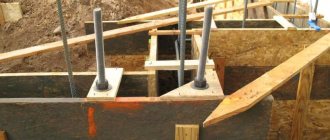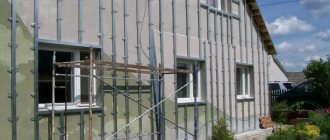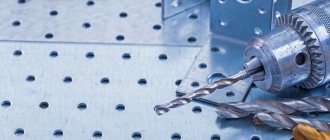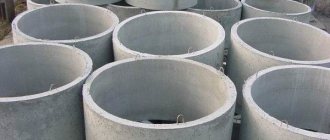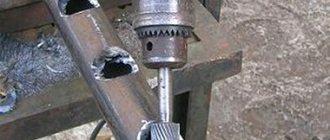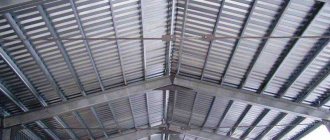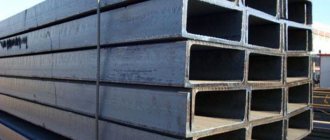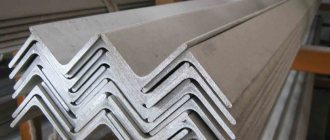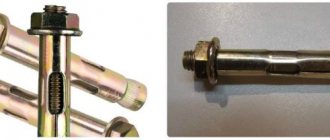Concrete is widely used for the construction of buildings, the strength of which makes it difficult to make holes for installing interior items, equipment, and household appliances. Standard nails and self-tapping screws that provide fixation to wooden surfaces cannot be used for concrete or brick. An anchor bolt allows you to solve the problem of fastening to various surfaces. Let's consider what an anchor bolt is and its use in the field of capital construction and private repairs. Let us dwell on the classification of fasteners and installation features.
What is an anchor bolt
Many have heard that to solve problems of fastening to the ceiling, internal and external surfaces of concrete walls, a special fastening element is used - an anchor bolt. Not everyone knows what it is. Let's try to figure out what an anchor is. This is a metal fastener that allows for reliable fastening of furniture, equipment and appliances on brick, stone, concrete and foam block surfaces, as well as on hollow panels and walls made of gas-filled blocks. The fastening element is installed in a hole with certain dimensions.
An anchor is a fixation device capable of absorbing significant forces due to the following factors:
- frictional forces, due to which the collet sleeve is held in the formed cavity;
- interaction forces of a special spacer mechanism with the inner surface of the channel;
- the adhesive characteristics of the adhesive ingredients located inside the drilled hole.
Among the many types of fixing devices, wedge-type anchors, as well as expansion anchors for concrete, are in high demand. Their design features and technical parameters allow the fixing element to increase the diameter of the working surface when decompressed inside the cavity. In this case, the magnitude of the friction force increases sharply. An anti-corrosion coating on the surface of such an element prevents the occurrence of corrosion and increases the service life.
Terms and Definitions. Classification
Official publication
Moscow
Form standards
2017
GOST R 57787—2017
Preface
Standard information
1 DEVELOPED by the Association "External Facade Systems" (Association "ANFAS")
2 8NESSEN Technical Committee for Standardization TC 465 “Construction”
3 APPROVED AND ENTERED INTO EFFECT by Order of the Federal Agency for Technical Regulation and Metrology dated October 12, 2021 No. 1397-st
4 INTRODUCED FOR THE FIRST TIME
The rules for applying this standard are established in Article 26 of the Federal Law of June 29, 2015 No. 162-FZ “On Standardization in the Russian Federation”. Information about changes to this standard is published in the annual (as of January 1 of the current year) information index “National Standards”, and the official text of changes and amendments is published in the monthly information index “National Standards”. In case of revision (replacement) or cancellation of this standard, the corresponding notice will be published in the next issue of the monthly information index “National Standards”. Relevant information, notification© and texts are also posted in the public information system - on the official website of the Federal Agency for Technical Regulation and Metrology on the Internet ()
© Standardinform. 2017
This standard cannot be fully or partially reproduced, replicated and distributed as an official publication without permission from the Federal Agency for Technical Regulation and Metrology
GOST R 57787—2017
Content
1 Scope……………………………………………1
2 Terms and definitions……………………………………………………1
3 Classification of anchors………………………………….6
Alphabetical index of terms in Russian……………………………7
Appendix A (informative) Classification scheme for anchors and anchors…………8
in
GOST R 57787—2017
Introduction
The classification introduced by this standard makes it possible to differentiate industrial anchoring equipment according to characteristic distinctive features.
The terms established in this standard apply to all types of industrial anchors and anchors used in construction.
The terms are arranged in a systematic order, reflecting the system of concepts in the field of anchors and anchor fastenings.
There is one standardized term for each concept.
For informational purposes, synonymous terms are given in the notes for individual terminology articles.
The given definitions can, if necessary, be changed by introducing derived features into them. revealing the meanings of the terms used in them, indicating the objects included in the scope of the defined concept. Changes must not affect the scope and content of the concepts defined in this standard.
IV
GOST R 57787—2017
NATIONAL STANDARD OF THE RUSSIAN FEDERATION
ANCHOR FASTENERS FOR CONSTRUCTION Terms and definitions. Classification
Anchor fastenings for construction. Terms end definitions. Classification
Date of introduction: 2018—01—01
1 area of use
This standard applies to anchors and anchor fastenings for fixing building elements, materials, structures and engineering or industrial equipment to the building foundation.
The classification and terms established by this standard are recommended for use in all types of documentation and literature in the field of anchors and anchor fastenings, as well as in the development of regulatory documents and the following types of technical documentation establishing standardized and other reliability indicators and service life of anchor fastenings:
• technological documentation for determining the design loads on anchor fastenings, the number and arrangement of fastening points;
• design and working documentation for the construction, reconstruction or repair of buildings, structures and other building structures.
2 Terms and definitions
1 anchor fastening: A unit of a building structure that structurally represents an anchor or an anchor group installed in a design position in a building foundation, while the anchor or each of the anchor group is capable of absorbing the loads acting on it and transmitting them to the building foundation.
2 pre-installation anchorage: Anchoring produced by pre-installing the component parts of the anchor into the building foundation and then fixing the element or material to be attached to them.
3 through-mount anchorage: An anchorage made by installing an anchor through an attached element or material directly into the building foundation while simultaneously fixing the attached element.
4 anchor: An industrial fastener designed for fastening building elements, materials, structures and equipment to a building base.
5 anchor group: a set of anchors involved in the work of anchoring according to the considered mechanism of achieving the limit state.
6 building foundation: An element of a load-bearing or enclosing structure that absorbs loads transmitted by an anchor from the attached element or material.
7 anchor rod: A component of the anchor, representing a smooth or threaded rod with a head of various configurations and designs, which absorbs the load from the attached structural element or other parts of the anchor and transmits it through the spacer zone or adhesion zone to the building base.
Note - The synonymous term “anchor spacer element” can be used.
Official publication
1
GOST R 57787—2017
8 anchor dowel: A component of a friction anchor that expands in the building base when the anchor is installed in the design position and transfers the load perceived by the anchor rod to the building base.
9 disc element: A component of a disc anchor, representing a plate intended for fixing materials to the building base, receiving loads from them and transmitting them to the spacer zone of the anchor.
Note - The synonymous term “disc holder” can be used.
10 mechanical anchor: An anchor in which the transmission of forces to the construction base from the anchor rod is carried out due to frictional forces or the abutment of the components of the anchor with the base.
11 chemical anchor: An anchor in which the transfer of forces to the building base from the anchor rod is carried out through a layer of a composition hardened as a result of a chemical reaction.
12 metal anchor: An anchor in the design of which the components that absorb the load from the attached structural element, and the components that transmit the load to the building foundation, are made of metal.
13 plastic anchor: An anchor in the design of which the component that transmits the load to the building foundation is made of plastic.
Note - The synonymous term “anchor with a plastic dowel” can be used.
14 thrust anchor: An anchor that, in its design position, resists the loads acting on it, due to the counterforces that arise in the area where the components of the anchor’s expansion zone abut the building foundation.
15 anchor with expansion: A thrust anchor that creates a thrust due to the expansion of the components of the anchor's expansion zone directly in the building foundation, during the installation of which it is necessary to expand part of the hole for the emphasis of the components of the anchor.
Note - See anchoring using widened anchors in Figure 1.
16 anchor with a wedging clip: A friction anchor, the design of which includes a wedging element in the form of a clip, and installation into the design position occurs by wedging the anchor clip inside the hole when tightening the nut, bolt or screw (depending on the design of the anchor) until the specified tightening torque is reached.
Notes
1 The synonymous term “anchor with tightening torque control” is allowed to be used.
2 See anchorage using a riveted clip anchor in Figure 2.
2
GOST R 57787—2017
Figure 2 - Anchoring using an anchor with a riving clip
17 self-tapping anchor-screw: A thrust anchor, the expansion zone of which is a self-tapping thread of sufficient strength to cut a counter thread in a concrete or masonry building foundation.
Note - See anchorage using a self-drilling anchor in Figure 3.
Figure 3 - Anchoring using a self-tapping anchor screw
18 friction anchor: An anchor that, in its design position, resists the loads acting on it due to the frictional forces that arise between the components of the anchor’s spacer zone and the building foundation.
Note - The synonymous term “expansion anchor” can be used.
19 drop-down anchor: A thrust anchor, the design of the expansion zone of which consists of drop-down elements to create a stop on the back side of the sheet building base. hollow and ribbed stone blocks (in design position).
20 anchor-sleeve: A friction anchor, the design of which is a sleeve with an internal thread and a wedging cone in the expansion zone: installation into the design position occurs by controlled movement of the cone relative to the sleeve to wedge the expansion zone of the anchor in the building foundation.
Notes
1 The synonymous term “anchor with displacement control” is allowed to be used.
2 See anchor fastening using a bushing anchor in Figure 4.
3
GOST R 57787—2017
Figure 4 - Anchoring using an adjustable anchor
21 adhesive anchor: An anchor in its designed position that resists the loads acting on it, due to the adhesion forces of the hardened chemical composition with the anchor rod and the building base.
22 expansion-adhesive anchor: An anchor that, in its designed position, resists the loads acting on it, due to a combination of expansion and adhesion forces of the hardened chemical composition with the anchor rod and the building base.
23 injection anchor: A chemical anchor, the installation of which involves injecting a chemical composition of one or more components in given proportions into a hole in the building foundation, after which an anchor pin is inserted into the hole with the solution that has not yet hardened.
24 capsule anchor: A chemical anchor, the installation of which involves introducing a capsule with a chemical composition of one or more components in specified proportions into a hole in the building base, after which a threaded rod of a shape is screwed into the hole as an anchor rod, allowing the capsule to be broken and the chemical composition to be evenly mixed in the hole.
25 disc anchor: An anchor in the design of which there is a disc element intended for fixing materials to the building base.
Applications
1 The synonymous term “anchor with a disc dowel” is allowed to be used.
2 See anchorage using a disc anchor in Figure S.
Figure S - Anchoring using a dowel anchor
26 anchor with a press washer: An anchor with a plastic dowel, the head of the metal rod of which is made with a press washer, and the design of the plastic dowel provides an insulating washer at the head of the dowel in order to prevent contact in the anchor fastening of the metal rod of the anchor with the attached structural element.
GOST R 57787—2017
Note - It is allowed to use the synonymous term “facade anchor” to describe anchors with a press washer, which does not in any way limit their use in other fastening units.
27 countersunk anchor: An anchor whose distinctive feature is the ability to install it flush with the element being attached.
Note - An anchor with a countersunk head can be an anchor of various types depending on the principle of fastening to the building foundation (3.2.1 of this standard) and the type of materials of the component parts (3.2.2 of this standard).
28 rigging anchor: An anchor whose distinctive feature is the shape of the outer part of the anchor rod, made in the form of a ring. An L-shaped elbow, eye, or other similar shape for gripping rigging fasteners.
Notes
1 It is allowed to use the synonymous term “overhead with a rigging grip”.
2 The rigging anchor can be a different type of anchor depending on the principle of fastening to the building foundation (see 3.2.1 of this standard) and the type of material of the parts (see 3.2.2 of this standard).
29 driven anchor: An anchor that is installed in the design position by driving the entire anchor or its component part.
30 screw-in anchor: An anchor that is installed in the design position by screwing the entire anchor or its component part.
31 anchor expansion zones: Linear section of the anchor. along which the loads perceived by the anchor are transferred to the building foundation.
32 installation diameter of the hole for the anchor: The linear dimension of the anchor fastening, indicating the diameter of the hole in the building base, necessary for installing the anchor in the design position.
Note - The synonymous term “anchor diameter” can be used.
33 installation depth of the anchor hole: The linear dimension of the anchor fastening, indicating the depth of the hole in the building foundation necessary to install the anchor at a given installation depth.
Note - The synonymous term “anchor depth” can be used.
34 anchor embedment depth: Linear dimension of anchor fastening, indicating the distance from the surface of the building foundation to the anchor point that is deepest in the building foundation.
Note - The synonymous term “anchor installation depth” can be used.
35 anchorage depth: The linear dimension of the anchorage, indicating the distance from the surface of the building foundation to the deepest point in the building foundation at which the anchor transmits the load to the building foundation.
36 load-bearing capacity of anchorage: Characteristic of anchorage, which is expressed by the value of the load corresponding to the limiting state of the anchorage.
37 limiting state of anchorage: A state of anchorage, if the characteristic parameters of which are exceeded, the operation of the anchorage is unacceptable, difficult or impractical.
38 service life of anchor fastening: The period of time from the start of operation of the anchor fastening until it reaches its limit state.
39 temperature range for installation of anchor fastening: The range of temperatures of the environment and the building base that allows installation of the anchor in the design position while fully satisfying all operational requirements for anchor fastening.
40 temperature range of operation of the anchor fastening: The range of temperatures of the environment and the building base that allows the operation of the anchor fastening in full satisfaction of all operational requirements for the anchor fastening during the entire service life.
S
GOST R 57787—2017
Types of anchor bolts and areas of their application
A fastener such as an anchor bolt is presented on the modern construction market in various designs. Along with universal fasteners of this type, manufacturers produce anchor bolts designed to solve highly specialized installation problems.
In order to choose the right fastener of this type, it is necessary not only to have a good understanding of its varieties, but also to know what types of anchors are used in certain cases. Let's consider the most popular types of anchor fasteners, their scope of application and the validity of their choice in a particular situation.
With nut
This is the simplest anchor, consisting of a threaded rod with a conical lower end, a spacer sleeve with longitudinal side slots and a nut, with which such a bolt is fixed in the mounting hole. The principle of operation of such a fastening device is quite simple: its entire structure is placed in a pre-prepared hole, the diameter of which must correspond to the transverse size of the spacer sleeve; when the nut is tightened, the threaded element begins to be drawn into the hole of the spacer sleeve, spreading it apart with its conical tip. Thus, the spacer sleeve, which has increased in diameter, ensures reliable fastening of the anchor bolt in the mounting hole.
Anchor bolts are made from various steels for fastening in dry places, with high humidity and for use in aggressive environments
Modern industry produces anchor bolts equipped with a nut in a wide range of sizes. Thus, the minimum diameter of such fasteners corresponds to 6 mm, and the maximum can reach up to 28 mm. As for the length, it can be in the range of 60–300 mm. When choosing such an anchor, you should keep in mind that it will be effective only in cases where fastening with its help is carried out in building materials with a dense internal structure (this includes concrete, natural stone, solid brick, etc.).
With hook
An anchor bolt of this type differs from the previous one only in that its upper part is crowned not by a straight threaded end, but by a hook, which makes it easy to install various attachments. The nut, also used in the design of such an anchor and located directly under its hook, is necessary only to ensure the expansion of the spacer sleeve and, accordingly, its reliable fixation in the wall or any other building structure.
Technical parameters of hook anchor bolts (click to enlarge)
The main convenience of this anchor bolt is that the object attached to its hook can be removed at any time if the need arises. Anchors of this type are most often used for mounting lamps and chandeliers, attaching water heaters and other household devices to wall surfaces.
With ring
This anchor differs from the previous one in that its upper part is crowned not with a hook, but with a ring or half-ring. Moreover, the principle by which it works is similar to the action of anchor bolts of the two previous types. The ring that ends the upper part of such fasteners is very convenient to use for mounting various objects and structural elements.
The anchor bolt with ring is protected by a white or yellow anti-corrosion coating
The dimensions of the structural elements of the anchor bolt with a ring can be different. It is successfully used for hanging various objects on ceiling structures; with its help it is very convenient to perform various stretches, attach cables, chains, cable routes, scaffolding, etc.
Anchor bolt with nut: typical dimensions and technical characteristics
According to the technical characteristics, the use of an anchor bolt is possible in monolithic materials, such as concrete. During the installation process, you must always take into account that when you tighten the nut, the stud moves out. The minimum length of the anchor pin is 18 mm, and the longest can reach a size of 400 mm. Depending on the length of the stud, its diameter also changes and can vary from M 6.5 to M 24. Since the anchor fasteners are made of metal, it provides reliable fastening of structural elements in the event of a fire.
Typical dimensions of an anchor bolt with a nut, table
Application of Anchor Bolt
Mechanical anchors are good for low-porosity substrates. Chemical models are indispensable for materials with an abundance of gas capsules, for example, cellular types of concrete. Installing an anchor bolt If you focus on the structure of the fastener: -A bolt with a hook or ring is good for fixing hinge systems, objects on cables and chains. It is important to be able to remove the item from the bolt to move it to a new place, or wash it and hang it back. -A bolt with a nut is used for dense and monolithic bases, since the spacer fastening system is not effective in porous and soft materials. The nut perfectly holds gates and stairs, secures cables and pipelines.
In everyday life, a concrete anchor bolt is useful for periodically dismantled structures. These are doorways and suspended ceilings. - Wedge bolts are also used in dense and monolithic foundations, both for capital construction and private farmsteads. Wedges are used to attach advertising boards to foundations, posters to house facades, warehouse consoles to walls, and light fixtures to ceilings. In everyday life, wedge bolts are often used when installing punching bags and home sports corners. -Anchors-studs hold ceilings and partitions, supporting consoles, masts, cables and antennas. Some types of anchors for dense foundations are divided into those suitable for true monoliths and those that have cracked.
The stud bolt, for example, comes in the HAS and HST categories. Models of the latter allow you to securely fix objects to cracked concrete and make through fastenings. This increases the "weight" of HST anchor bolts in the eyes of builders. The nuances of using anchors depend on their weight, size, and material. There are, for example, brass or steel bolts. If the fastener is made of an iron alloy and is an M-6 size, it will withstand up to 2.8 kilonewtons of pullout. The shear anchor will withstand 3.6 kilonewtons. As a rule, the performance characteristics of anchor bolts are indicated on their packaging. It remains to correctly calculate the stress forces in the walls and ceilings. If you are not confident in your abilities in the exact sciences, it is better to order calculations from professionals or play it safe by taking the most reliable fasteners. They appear to be useful in most areas of construction, since they can even withstand load-bearing structures such as ceiling beams.
Rules for installing an anchor bolt with a nut
The quality of installation has a significant impact on the further operation and load-bearing capacity of the anchor. In essence, there is nothing complicated in installing these fasteners, and they are all installed according to the same principle, but there are a number of simple rules that must be followed to ensure that your fastening is reliable and durable. To ensure the required quality it is necessary that:
- The size, that is, the diameter of the fastening hole, does not exceed the outer diameter of the spacer sleeve, otherwise wedging the sleeve will not provide the necessary fastening strength. Pay special attention to the choice of drill, consider its wear. If the bushing does not fit into the drilled hole, you should not drill with a large drill, try repeating the drilling with the same drill, this will somewhat “break” the mounting hole and allow you to install the anchor in place;
- The mounting hole was free of concrete residue, dust and other construction debris that would prevent the anchor bolt from being installed in the desired position;
- When attaching structural elements to an already installed anchor, first tighten the lock until it stops so that the spacer sleeve takes the working position. After this, unscrew the nut and mount the required element on the rigidly installed rod.
Installation of an anchor bolt with a nut in concrete video
When carrying out repair and construction work, you can use various types of fastening systems, but it is the anchor fastening that provides the greatest strength.
Anchor bolt price
The price of an anchor bolt depends on its type and size. The fame of the manufacturer also plays a role. Consumers are willing to overpay for brands with traditionally good quality. Generally speaking, the cost of anchor bolts starts from 25 rubles and reaches 550 rubles per piece. Take, for example, an HST stud of size M20 by 170 made of steel. For this they ask about 310 rubles. Anchor with a ring If size M8 is 115, the price of the anchor will be 60 rubles. HSA bolts are cheaper because they are not suitable for complex, cracked foundations. With a size of M20 by 170, the price of the anchor is already 230 rubles.
The most expensive are chemical anchors. They are innovative and are already replacing mechanics in the European market. Russian consumers are still poorly informed about chemical fasteners. Builders have already felt a “taste” for the new product and are actively recommending it to customers. Therefore, experts predict that chemical anchor bolts will soon dominate the domestic market. Increased demand will help reduce the price of the product slightly.
Marking of anchor bolts
When planning to use anchor bolts for concrete, you need to learn how to determine the dimensions by markings. Let's figure out how the abbreviation stands for the example of a fastener with the designation M8 10/35x90:
- The alphanumeric designation M8 indicates the thread diameter;
- the number 10 corresponds to the diameter of the drill for making a cavity in concrete;
- the number 35 indicates the maximum thickness of the attached material;
- the number 90 characterizes the minimum depth of the hole for installing the anchor.
Knowing how anchor bolts are marked, it is easy to select fasteners to perform a specific task.
Different Types of Foundation Anchor Bolts
Curved foundation anchor bolts Type 1.1 Type 1.2
Foundation bolts with anchor plate Type 2.1 Type 2.2 Type 2.3
Composite anchors Type 3.1 Type 3.2
Removable foundation anchor bolts Type 4.1 Type 4.2 Type 4.3
Straight foundation bolt Type 5
Anchors with tapered end Type 6.1 Type 6.2 Type 6.3
Designation of parts: 1 – 10 – hairpin; 11.12 - anchor plate; 13 - coupling; 14 - anchor reinforcement; 15 — expanding collet; 16 — conical bushing; 17 — washer; 18 — nut according to GOST 5915-70; 19 — nut according to GOST 10605-72
Dimensions of anchor bolts GOST 24379.1-80
| Bolt type | Execution | Bolt name | Nominal thread diameter, mm |
| 1 | 1 | Curved foundation bolts | M12 - M48 |
| 2 | |||
| 2 | 1 | Foundation bolts with anchor plate | M16 - M48 |
| 2 | M56 - M90 | ||
| 3 | M100 - M140 | ||
| 3 | 1 | Composite foundation bolts | M24 - M48 |
| 2 | M56 - M64 | ||
| 4 | 1 | Removable foundation bolts | M24 - M48 |
| 2 | M56 - M125 | ||
| 3 | M56 - M100 | ||
| 5 | Straight foundation bolt | M12 - M48 | |
| 5 | 1 | Tapered End Foundation Bolts | M12 - M48 |
| 2 | |||
| 3 |
Design of anchor plates for anchor bolts
Dimensions of anchor plates for anchors
| Nominal diameter of stud thread d, mm | D, mm | B, mm | S*,mm | Theoretical mass of the slab, kg |
| 16 | 22 | 65 | 14 | 0,42 |
| 20 | 26 | 80 | 16 | 0,74 |
| 24 | 32 | 100 | 18 | 1,3 |
| 30 | 38 | 120 | 20 | 2,08 |
| 36 | 45 | 150 | 20 | 3,28 |
| 42 | 50 | 170 | 25 | 5,29 |
| 48 | 60 | 190 | 28 | 7,31 |
| 56 | 66 | 220 | 32 | 11,21 |
| 64 | 74 | 260 | 36 | 17,8 |
| 72 | 82 | 300 | 40 | 26,41 |
| 80 | 90 | 320 | 45 | 33,7 |
| 90 | 100 | 360 | 50 | 47,5 |
Example of a symbol:
PLATE 120 GOST 24379.1-80
Anchor plate, size B = 120 mm
Anchor bolt - advantages and weaknesses
All types of anchors are universal elements that allow fastening to walls made of various materials. However, given the cost of anchors, it is not economically feasible to use them for fastening light objects in wood walls. The product is designed to provide a reliable connection in hard materials such as stone, concrete and brick.
The anchor bolt has increased load capacity
Using specialized fasteners for their intended purpose, you can fully appreciate its advantages:
- increased load capacity. According to this parameter, the anchor occupies a leading position among other hardware;
- expanded range of fasteners. It is easy to choose the best option taking into account the installation features;
- Application for the manufacture of carbon steel fasteners. It is resistant to corrosion and is durable;
- ease of installation operations. Fixation does not require special equipment, and installation is carried out in a limited time;
- the possibility of using anchors to strengthen the existing structure;
- resistance to stress. The immobility of the anchor is ensured both statically and dynamically with the application of vibration loads.
Along with the advantages, there are a number of disadvantages:
- increased cost of products compared to other types of hardware;
- the need to first make a hole in a solid base;
- selection of the design of the anchor used depending on the base material.
An anchor bolt for concrete is an indispensable element in the arsenal of home craftsmen and professional builders who fully appreciate its advantages.
Material
The strength of the fastening element is one of the most important parameters characterizing hardware. The strength of the fastening directly depends on the type of material from which it is made. Depending on the strength characteristics, the metal for production and the mode of its heat treatment are selected.
Most often, standard bolts are made of alloy and non-alloy steel. But in some cases they can be made of other metals, such as copper, aluminum, which are used in cases where there is no need to achieve high fastener strength. For jewelry making, fasteners can be made from precious metals such as gold, silver and others.
Depending on the type of material used, the designation of the bolts, called assortment, depends, by studying which you can understand what the bolts are made of.
Very often, to improve the technical characteristics of hardware, a special coating is used that protects the fastening element from environmental influences (humidity, water, temperature range, chemicals).
Among the most common coatings are the following varieties:
- Zinc. The thickness of the zinc coating can vary depending on the requirements. For bolts used in household appliances, the thickness is usually small. But for industrial fasteners it is usually up to 25 microns.
- Cadmium-plated. Not a very common type of bolt, due to the toxic properties of cadmium. Therefore, they are used in rare cases when coatings made of other materials do not allow achieving the desired performance characteristics.
- Nickel. Typically used for fasteners used in furniture production. Nickel only improves decorative characteristics and practically does not change operational characteristics.
- Phosphating and oxidation. They are used to create a protective layer on the surface of bolts due to oxidation of the base metal.
- Zinc lamellar. They are becoming widespread because they can increase the service life of fasteners several times.
How do metal anchors differ in design?
An anchor bolt, the principle of operation of which has specific features for various types of fasteners, is a mechanical lock. Its peculiarity is that the transverse size increases when screwed in.
Wedge anchor 6x100
Let's consider how fasteners are divided into types depending on the design features:
- wedge anchor bolt. It is made in the form of a metal pin with a collet sleeve, which, when the rod is screwed in, increases in diameter and wedges into the cavity. This is achieved by moving the cone-shaped part of the rod inside the spacer sleeve. A nut is screwed onto the threaded part of such an anchor, under which there is a washer. The wedge clamp is installed in a pre-drilled hole, followed by tightening the nut with an open-end wrench. When the pin moves during the screwing process, the tapered sleeve comes into contact with the collet clamp, which opens and wedges. Such a fastening element is capable of withstanding increased loads. However, it creates increased stress in the material over the contact area, which does not allow its use in cellular concrete;
- sleeve anchor with nut. Sleeve-type metal anchors are equipped with a fixing sleeve, the length of which is equal to the size of the steel rod. There is a wedge-shaped head on the tail part of the pin. When the nut is screwed in, it moves along the threaded part. As a result of the movement, the sleeve expands. The design features of this type of fastener allow it to be used in light types of concrete with a cellular structure, as well as in bricks made from baked clay. The possibility of use in brittle materials is associated with the reduced amount of stress that such an anchor creates inside the channel. There are no special requirements for installation work, which allows for end-to-end installation. Compared to a wedge clamp, a sleeve clamp has a reduced load capacity;
- expansion type collet bolt. The expanding type of fasteners is a modernized version of the sleeve clamp, but has a more complex design. Longitudinal cuts on the expansion sleeve divide its surface into four petals, which, under the influence of the spacer element, partially open, increasing the cross-sectional size. Fixation is ensured both by forces associated with friction and by changing the shape of the working surface. The load capacity of the expanding element with a collet corresponds to the characteristics of a wedge anchor. The difference is the reduced stress in the contact area with the material. The product is used in hollow bricks and light types of concrete. The increased cost of the anchor limits its widespread use;
- drive-in anchor bolt for concrete. The design feature of this clamp is the shape of the inner surface of the spacer sleeve, which is made in the form of a cone with cuts. There is a wedge inside the sleeve, which, when impacted, moves inside the cavity and expands the sleeve. The drive-type fastener is designed for installation in concrete structures and solid bricks, since high thrust forces are created in the area of contact with the material. Installation is quite simple and quick.
When choosing an anchor bolt for concrete or other material, you should take into account its design features.
By thread type and pitch
For different types, several types of thread are used. Among the most common are the following:
- Metric - refers to a group of screw threads that are applied to the outer part of the rod. The shape of the grooves and protrusions forms an isosceles triangle. The parameters of this thread are measured in millimeters, which is why it got its name. This type of thread is the most common; most often it can be found using ordinary and anchor bolts.
- Inch - also has a triangular profile, the only difference is that its parameters are measured in fractions of an inch.
- Pipe.
- Trapezoidal - differs in the shape of the depressions and protrusions, which are not triangular, but trapezoidal. This allows you to create a large friction force, which does not allow the bolt to unscrew on its own during operation.
- Thrust – used for increased lateral loads; the cross-section has the shape of a right triangle.
- Rectangular - used in cases where fasteners must perform their functions under heavy loads.
How to use anchors correctly
If you are going to attach the required object to a wall, floor or ceiling made of brick, concrete or drywall, an anchor bolt is the best fastener to help you do this. There are many types of anchor bolts, some of which must be installed into the wet cement and others after the concrete has dried. Consult with StroyMashService professionals if you want to select the appropriate anchors for your project.
Preparation
First you need to determine the size of the bolt and fastener that will hold whatever you are attaching to the surface. The bolts should be chosen so that they can withstand the required load, but they should not be placed too close to each other, as this can damage the surface.
Factors that affect strength include the weight the bolt must support, the force applied to the bolt, and the temperature it will be exposed to. There are different types of anchor bolts suitable for different types of jobs.
Choose the right bolt to suit your purpose
Decide on the area and timing of bolt installation. Are you going to install it in concrete that has not yet dried or in already hardened concrete? If necessary, make a hole in the surface using a drill or awl. For drywall, an awl is preferable to avoid dulling the drill and damaging the surface.
However, when installing brick or other stone into a concrete surface, it is worth using a stone drill. To install a bolt in drywall, you need to make a hole with a diameter slightly smaller than the diameter of the bolt.
Installation
Place the anchor in the hole. If necessary, hammer it in with a hammer. It should fit snugly against the walls of the hole. Screw the bolt into the threaded shaft of the anchor and immediately tighten it. The anchor spacers should open up and grip the material without allowing the bolt to pop out.
Tools you may need:
- Hammer
- Screwdriver
- Drill
- Awl
- Stone drill
